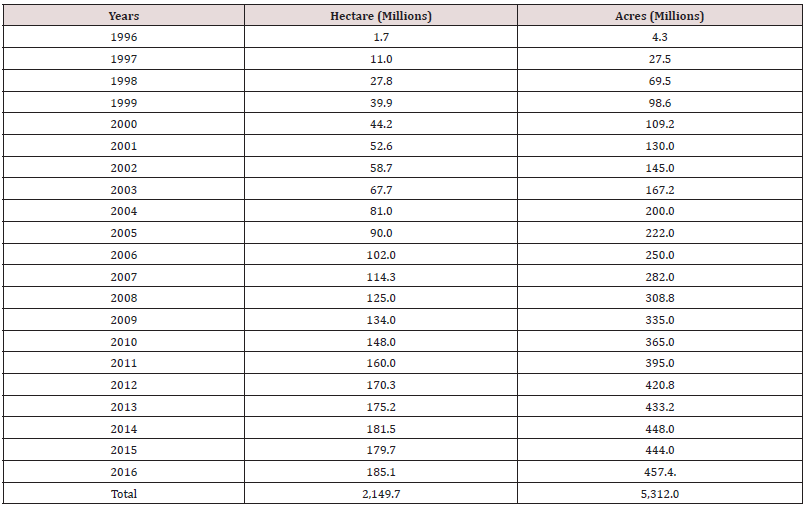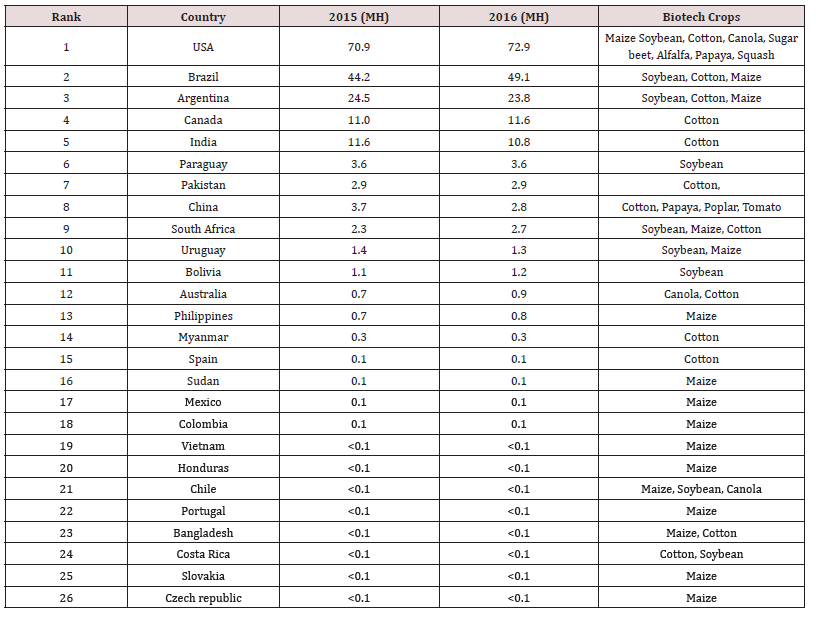
Lupine Publishers Group
Lupine Publishers
Menu
ISSN: 2641-1725
Short Communication(ISSN: 2641-1725) 
Biotechnology Plays a Significant Role to Control Insect Pests of Agricultural Crops Volume 2 - Issue 3
Umar Niaz* and Burhan Ahmad
- Department of Entomology, University of Agriculture, Pakistan
Received: November 27, 2018; Published: November 30, 2018
*Corresponding author: Umar Niaz, Department of Entomology, University of Agriculture, Faisalabad, Pakistan
DOI: 10.32474/LOJMS.2018.02.000136
Introduction
Today insect pests have been one of most important problem in food production. Previous research have been proved that 1/3 of agricultural production of world, prized at several billion dollars is ruined by damaging of field and storage insect pests every year. Various toxic, broad-spectrum and synthetic chemicals are used to control pests. Natural ecosystem, human health and our environment can be affected due to excessive use of these harmful chemicals. So now biologically based approaches are developing to control insect pest instead of toxic and synthetic chemicals which are ecofriendly, cost-effective and useful and reliable. There are different types of bio pesticides such as arthropods natural enemies (predators, parasitoids, and parasites), entomopathogens (bacteria, fungi, virus and nematodes), insect hormones and plant derived bio pesticides.
Role of Biotechnology
It is a set of techniques for manipulation of living organisms or their components to produce useful commercial products such as new bacterial strains, pest resistant crops. There are various techniques are used in biotechnology like biological fixation of nitrogen, tissue culture and organic pest control. Previous research have been proved that Bacillus thuringiensis (Bt) was discovered in 1906 by mortality of silkworm larvae. Bacillus thuringiensis stands out on the world stage since 1938, when first product was formulated with this pathogen released in France. In 1911 A German scientist Berliner succeeded to detach and characterize this bacterium has cylindrical shape and “thuringiensis” named after German region “Thuringia”. In1938 France formulations having bacteria colonies was sold as an insecticides. In 1954 Mode of action was revealed and its usage today. Bt is known as soil bacteria which is found in different countries, Gram positive, aerobic and its family is bacilaceae.
It can sporulate to survive when environmental conditions become adverse and unfavorable. This is found in dead insects, plants and debris. This produces sporangia containing endospores and crystalline inclusions of proteins (CRY) which are responsible for their action against lepidopterans insects. This Crystal is composed of polypeptide protein that is called endotoxin. When larvae feed on such proteins initiates the number of reactions that kills them.
Biotechnology Better Than Insecticides:
Recent researches have been found that insect pests are major problem for agricultural crops, and losses due to diseases and insect pests are very high.to manage insect pests we use various harmful agrochemicals day by day on large scale and use bio pesticides just on small scale. Survival of natural enemies (predators, parasitoids and parasites), human health, beneficial insects, and environment are badly affected by unselective use of chemicals. It also produce resistance in insects against agro chemicals. On the other hand, Bio pesticides used over a country which is less harmful for environment and human beings than synthetic chemicals. To control insect pests’ new strategy has been developed which consists of genetically modified plants resistance against insects, and they are similar and effective like conventional insecticides. In 1986 the first experiments with genetically modified (GM) plants were made in the United States and in France.
The first variety marketed a vegetable species produced by genetic engineering was the “FlavrSavr Tomato” developed by the American company Celgene and marketed from 1994. 1987- 2000 there were more than 11,000 field trials in 45 countries and tested were corn, tomatoes, soybeans, canola, potatoes and cotton, and development of safer and more effective technologies genetic features announced were herbicide tolerance, product quality, virus-resistance and resistance to insects (Table 1).
Area of Biotech Crops in developing and industrial countries:
In 2016, 19 developing countries cultivated 54% biotech crops on 99.6 million hectares out of worldwide biotech cultivation area while 46% biotech crops were planted on 85.5 million hectares in industrial countries.A new biotech crop rice which is grown in developing countries (Table 2).
Mode of Action of Cry in Bt Cotton:
This protein is inactive protein. This requires Alkaline Ph. (7.5- 8) for activation. This is only harmful for lepidopterist insects and not for sucking insects and other organisms because lepdopterous insects have this alkaline ph. medium which is required for activation of Cry. When insect attacks on cotton plant this toxin enters into body and become activate. Active toxin binds with protein receptors on epithelial cells within midgut. Then this toxin forms pores and puncture the midget so insect will be die due to starvation.
Major applications of Cry toxins
i. Control of deflator pests
ii. Control of mosquitoes which cause a vector for human diseases
iii. Development of transgenic crops

Top Editors
-

Mark E Smith
Bio chemistry
University of Texas Medical Branch, USA -

Lawrence A Presley
Department of Criminal Justice
Liberty University, USA -

Thomas W Miller
Department of Psychiatry
University of Kentucky, USA -

Gjumrakch Aliev
Department of Medicine
Gally International Biomedical Research & Consulting LLC, USA -

Christopher Bryant
Department of Urbanisation and Agricultural
Montreal university, USA -

Robert William Frare
Oral & Maxillofacial Pathology
New York University, USA -

Rudolph Modesto Navari
Gastroenterology and Hepatology
University of Alabama, UK -

Andrew Hague
Department of Medicine
Universities of Bradford, UK -

George Gregory Buttigieg
Maltese College of Obstetrics and Gynaecology, Europe -

Chen-Hsiung Yeh
Oncology
Circulogene Theranostics, England -
.png)
Emilio Bucio-Carrillo
Radiation Chemistry
National University of Mexico, USA -
.jpg)
Casey J Grenier
Analytical Chemistry
Wentworth Institute of Technology, USA -
Hany Atalah
Minimally Invasive Surgery
Mercer University school of Medicine, USA -

Abu-Hussein Muhamad
Pediatric Dentistry
University of Athens , Greece

The annual scholar awards from Lupine Publishers honor a selected number Read More...















